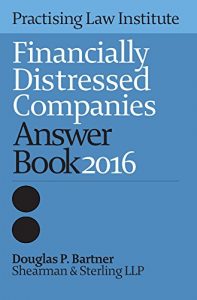In order to survive, a company in financial distress must approach its business and capital structure differently than a financially sound company. A company in financial distress may, for example, need to preserve cash by stretching accounts payable, to raise cash by selling assets, or to arrange for emergency liquidity from institutional lenders. The response of a company to its deteriorating financial condition will almost certainly affect, perhaps in material ways, a company’s key constituents.
Financially Distressed Companies Answer Book 2016 provides a broad overview of topics relating to financially distressed companies. It is intended to be an easy reference with respect to issues for the management of a company finding itself in financial distress, a vendor or other creditor trying to manage its exposure or understand a bankruptcy process, or a nonbankruptcy lawyer needing a description of the legal concepts relevant to distressed companies. The book provides answers detailed enough to provide a working understanding of concepts, and relevant statutory and case law cites to facilitate any necessary further reading. Examples and practice tips help illustrate concepts and provide practical guidance.
Topics discussed in Financially Distressed Companies Answer Book 2016 include:
- The roles and fiduciary duties of directors and management in distress situations;
- Rights and limitations of creditors in dealing with companies in distress and in bankruptcy;
- Concepts and considerations relating to out-of-court restructurings;
- Cross-border reorganizations and issues in international restructurings;
- Key concepts in U.S. bankruptcy cases; and
- Special rules in bankruptcy for small businesses and single asset real estate companies.
Financially Distressed Companies Answer Book 2016 also provides you with:
- Illustrative timelines to help guide strategic planning;
- References to sources of additional information, such as bankruptcy court websites; and
- Practice and cautionary tips to provide guidance on issues such as how to recognize financial distress, when the securities laws might require disclosure and what actions a creditor may take to protect its rights or limit its exposure.



